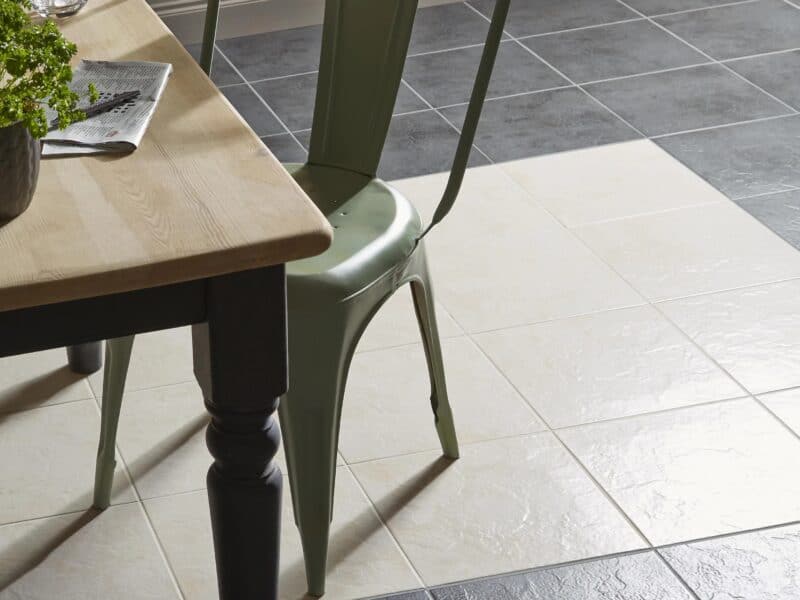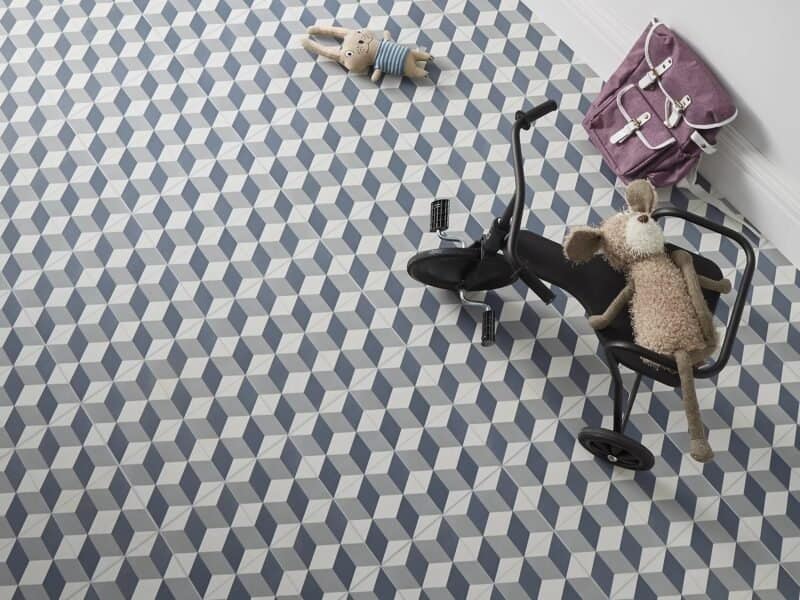Tile flooring is one of the most versatile forms of floor covering with styles catering for every taste and a durable, easy-care surface suitable for every kind of lifestyle.
It is not surprising, therefore, that it is one of the most popular choices of flooring and is used in a variety of domestic and even commercial situations.
Why is Tile so Popular?
For those wishing to install Hard Surface Flooring, tile offers one of the most durable options. It is especially suitable for high traffic areas, such as entrances and in kitchens and other high activity rooms.
It is also one of the easiest to clean, especially where heavy soiling is involved so again, it is popular in doorways and other entrances where outdoor dirt and moisture is likely to enter the house.
Similarly for kitchens and bathrooms, its stain-resistant, waterproof surface means easy care, Cleaning and Maintenance.
Furthermore, tile is inherently attractive with a natural, hand-crafted look that suits a variety of decor themes and offers the possibility of limitless design patterns with differing combinations of size, texture and colour.
What to Look for When Selecting Tile Flooring
Most floor tiles come manufactured to standard sizes, from 4″ x 4″ up to 24″ x 24″ and are usually ½ to ¾ of an inch thick. Although usually square in shape, they can come in a variety of other shapes, such as octagonal and hexagonal.
People usually base their choices on personal preference of colour and style but it is important to take a few other things into consideration as well.
For example, it is important to make sure that the tile is rated for the type of exposure and wear it will receive.
This basically depends on where you plan to install it; bathrooms, for instance, will need a water-proof, non-slip surface whereas doorways and entrances require an extremely durable and hard, abrasion-resistant type of tile.
Ideally, they should also be water-resistant and non-slip (especially in countries with frequent wet weather, such as the UK); this means treating the surface of the tile so that it becomes ‘rougher’ and therefore provides more traction or grip.
Tiles that are intended for outdoor use need to be of a material for outdoor use only (and some tiles can be used for both outdoors and indoors).
Tiles are rated using a series of standardised tests which evaluate their relative hardness and durability under wear and tear.
This is dependent partly on the firing process: usually the longer and hotter the firing, the harder the resulting tile.
When tiles are ‘double-fired’ this means that they are baked a second time after colour or other decoration has been added following the first firing and such tiles are usually thicker.
The tests also measure the amount of water absorbed by the tile. This is termed the porosity and can be a very important value, especially when you are considering tiles for bathroom and kitchen floors.
Tiles are usually categorised into Impervious (least absorbent), Vitreous, Semi-vitreous and Non-vitreous (most absorbent). In addition, porous tiles should be avoided outdoors in areas of extreme cold weather and the likelihood of freezing and thawing.
Types of Tile
Porcelain This type of tile is probably considered the ‘luxury’ end of the tile market; porcelain is fired at extremely high temperatures, making it very dense and therefore incredibly hard, resistant to wear and tear (especially foot traffic) and most importantly, resistant to moisture.
In fact, it is often used as an alternative to stone tiles and is frequently chosen as an ornate option for kitchens and bathrooms.
Porcelain

Available from B & Q
Porcelain comes in a range of colours and finishes and can be installed glazed or unglazed. Its premium look means that it has gained popularity in both domestic and commercial settings, with its combination of sophistication and practicality.
Ceramic

Available from B & Q
Probably the most common type of tile, Ceramic is made from clay and/or other minerals using the traditional kiln firing method; one of the most efficient methods of production.
The extruded material is usually shaped and then fired in the kiln, before being further treated with glazing. This means that colour is added and a glass-like surface bonded to the tile. It also means that brighter colours can be used and the tile is made more stain-resistant.
Tiles can also be left unglazed (see quarry tiles); if so, such tiles need to be sealed in order to provide stain resistance.
Ceramic tiles come in a huge range of colours and styles and are popular for their simple beauty and their easy maintenance.
Brick
Brick Brick tiles are usually used in outdoor settings and come in a range of earth tone colours. As they are porous, they need to be treated with a stain-resistant sealer. They can also be used indoors and tend to be favoured as part of a rustic décor or an informal interior scheme.
Cement
Made by pouring cement into moulds which are then fired or left to dry naturally, cement tiles can come as natural or have colour added. It also requires sealing to prevent staining and moisture seepage. Again, it is more commonly used in outdoor settings.
Quarry
Another name for unglazed tile, quarry is often used in commercial settings as it is relatively cheap but still very durable. It is clay-based and usually comes in earth shades of red and orange.
Saltillo
A particular type of tile which has a very rustic appearance, these tiles are the complete opposite to the highly refined urban look of porcelain tiles and may be ideal for certain décor themes.
Mosaic

Available from B & Q
These can be porcelain or ceramic but their defining feature is that they are two inches square or smaller. They are often mounted on mesh or paper sheets, although they can also be installed individually. They also come in glazed or unglazed form.
Terracotta

Available from wallsandfloors.co.uk
Similar to the material used in clay garden pots, terracotta is known for its distinctive earthy colour, however, remember that they are porous and very absorbent and therefore need to be treated with sealer for outdoor use.
Pavers

Similar to bricks and quarry tiles, these are largely used for outdoors, although some are installed as interior flooring. Again, they need to be sealed for moisture and stain-proofing and they tend to be thinner than brick.
Cold Feet?
The one problem with tile flooring is cold feet, particularly in chilly weather and it is also not very comfortable or cosy to sit on tile flooring in such climate conditions.
However, the strategic use of Soft Rugs, preferably thick and plush, will solve this problem and provide not only comfort underfoot but also an inviting surface for children and adults to sit and play on.


